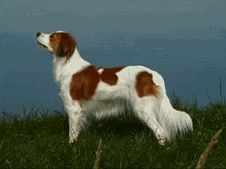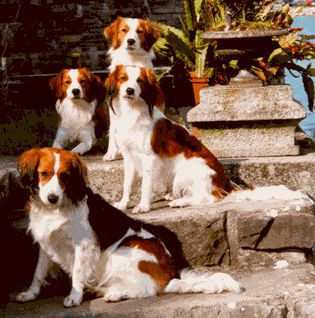|
ORIGIN: The Netherlands DATE OF PUBLICATION OF THE ORIGINAL VALID STANDARD: 10.03.1989
CLASSIFICATION F.C.I.: Group 8 Retrievers-Flushing Dogs-Wather- Dogs. Selection 2 Flushing Dogs. Without working trial BRIEF HISTORICAL SUMMARY: This Dutch breed ist now officialliy recognized. The interim standard was approved by the << Raad van Beheer>> on June 18. 1966. As she had already done with numereous other breeds, Baroness van Hardenbroek added another jewel to the Dutch breeds. Good quality speciments in sufficient number are now being bred. The annual meeting of the Kooikerhondje played an important part in the development of this sporting breed. GENERAL APPEARANCE: Agile parti-coloured dog with a nearly square body. It has a well feathered tail and a high head carriage. IMPORTANT PROPORTIONS: The length of the body is slightly more than the height at withers. Length of the skull about equal to the muzzle. BEHAVIOUR/TEMPERAMENT:
Cheerful, but not noisy, very dependent
on its domestic environment, |
 UTILIZATION: This little spaniel which worked formerly and is
still working so successfully in duck decoys,
is a true sporting dog with a lively temperament. It is hamoniously built. Its coat
is shiny,
nicely coloured and well feathered.
UTILIZATION: This little spaniel which worked formerly and is
still working so successfully in duck decoys,
is a true sporting dog with a lively temperament. It is hamoniously built. Its coat
is shiny,
nicely coloured and well feathered. BODY:
BODY: